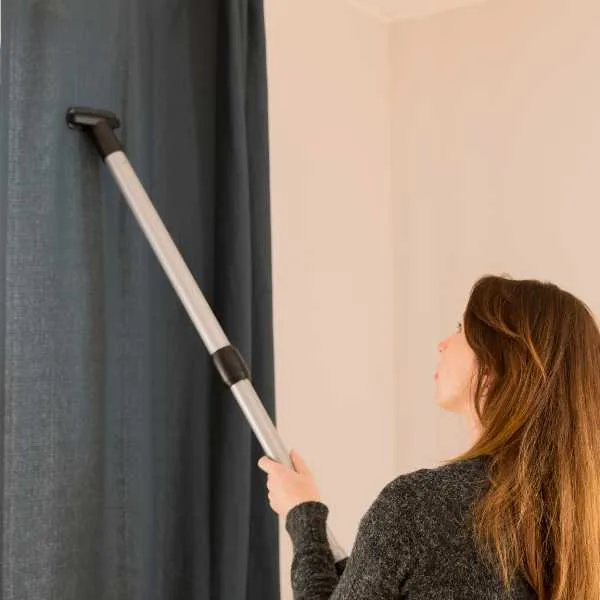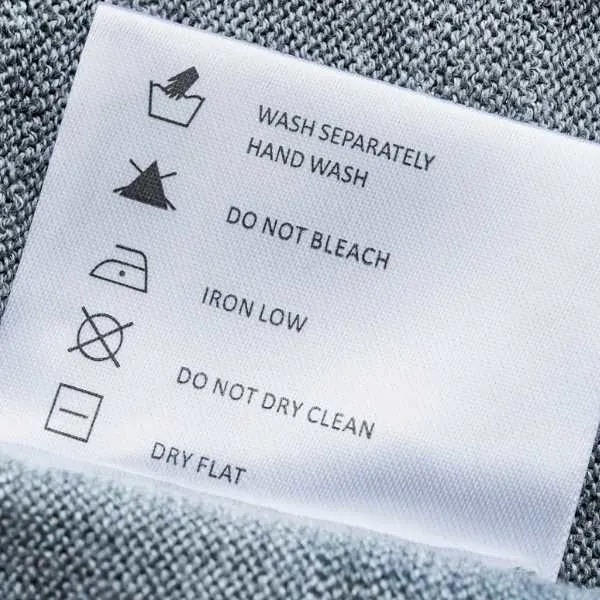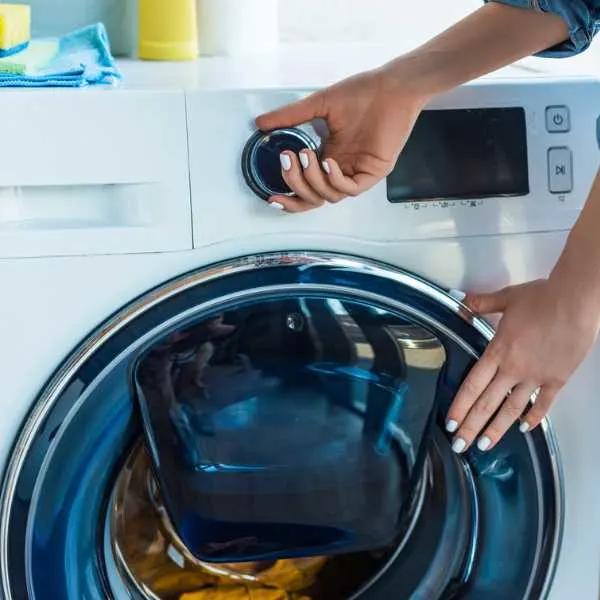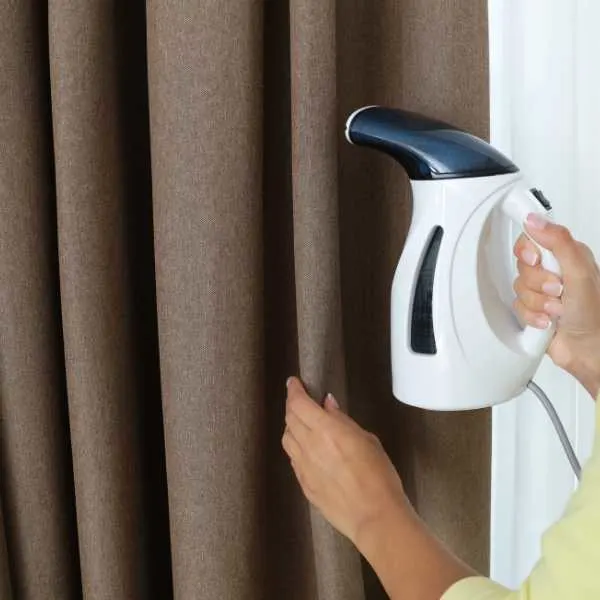Washing Curtains and Drapes: How Often Should You Wash these Window Treatment?
I have had some of my readers ask: “How often should you wash curtains and drapes?” So I thought I would provide simple guidelines for how often to wash your curtains.
Paging through America’s Housekeeping Book, first published in 1941, I was stunned at how hard our grandmothers and great-grandmothers worked to keep their homes clean.
Daily, weekly, and seasonal cleaning schedules for all rooms, windows, walls, and curtains. Glancing around my home, I suddenly asked myself: How often should you wash curtains?
Clean curtains and drapes at least once or twice per year by hand, machine, or dry cleaning. Wash curtains monthly or quarterly if your family has allergies, smokers, or pets, or if you live in a dusty or humid environment. Weekly vacuuming and spot-cleaning help maintain curtains between washes.
While we’re not tied to 1950s cleaning schedules, getting around to vacuuming the carpet, changing sheets and towels, and emptying the dishwasher happens regularly. But how often do we remember to launder the curtains?
I discovered that curtains are neglected in our homes, not being cleaned as often as they should. Let’s look at why and how often curtains and drapes need to be cleaned.

How Often Should You Wash Curtains and Drapes?
How often you clean your curtains and drapes depends on your family and lifestyle. The minimum is once or twice a year, but this increases in certain circumstances.
Although curtains are not a high-use item like a couch or doormat, they can collect dust, pet hair, and dander. These, along with their partners-in-crime, dust mites, can trigger allergies and cause asthma.
Curtains and drapes also absorb odors from cooking, fireplaces, and smoking. They can get stained by spillages and faded by the sun.
Here are recommendations for a curtain and drape-cleaning schedule:
- Clean all curtains and drapes every two to three months if your family members suffer from allergies, especially to pets, dust, and pollen.
- Smokers should have their drapes cleaned every three to six months to prevent odors and yellow staining.
- If you live in a dusty area, like on a dirt road, near a quarry, or on a farm, wash the curtains twice to thrice a year.
- If you live in a coastal area, salt and mold can build up on curtains, so wash them at least twice a year.
- If you have wood, coal, or anthracite heaters or fires indoors, clean the curtains after the winter season.
- Have your curtains cleaned as soon as they show any signs of mud, greasy fingermarks, mildew, or water damage to prevent permanent stains.
- In general, clean your drapes and curtains every year.
How to Maintain Curtains and Drapes Between Washes
Keeping your curtains and drapes in good shape between washes will prevent dust, cobwebs, mildew, and odors from building up. Good maintenance helps reduce allergies and allows you to notice spots, stains, or tears and take action immediately.
Vacuuming and Dusting

Here are some tips for daily or weekly curtain maintenance:
- Light, easily removable curtains can be shaken and hung in the fresh air.
- Use your vacuum cleaner to clean heavier drapes – the upholstery brush attachment is ideal for picking up dust and fluff between the folds. Always begin on a low suction setting to avoid damage, moving from top to bottom. Pay careful attention to sides and hems, and remember to vacuum the lining.
- To stop the vacuum cleaning from sucking up the fabric of lighter curtains, tape mesh over the brush attachment.
- Dust accumulates along the tops of curtains, especially the pleats and gathers, so use a long-handled duster, Swiffer, or vacuum attachment to clean it out.
- Check the hems of the curtains, as this is where dirt and pet hair can build up, staining the curtains. Use a lint roller or a piece of sticky tape to remove the dust and hair. If the hem is dirty, it’s a sign that the curtains need cleaning.
- Fabric refresher will neutralize odors so that the curtains stay fresh-smelling between washes.
- Keep the windows, sills, and curtain hardware free of dust.
Spot Cleaning
If you notice a stain or spot on your curtains, it doesn’t mean you have the wash the entire panel. Clean spots as you would on a tablecloth, rug, or blouse:
- Remove the spill with the back of a knife or spoon.
- Blot the stain, using a clean white cloth and a vinegar-water solution.
- If the stain remains, blot it with the cloth and a drop of mild detergent.
- Rinse by blotting with water.
- Allow the spot to air dry.
How to Clean Curtains and Drapes
Curtains and drapes can’t just be tossed into the washing machine, along with socks, towels, and dirty shirts. You need to take extra care to keep these pricey window treatments fresh and sparkling.
Check the Cleaning Instructions

Before cleaning any curtains or drapes, read the care label to ensure you’re doing the right thing. Curtain and drapery fabrics can be very sensitive, and the rough activity of a washing machine, strong detergents, and high temperatures can ruin them.
Ensure you check both the curtaining fabric and lining in case they have different care instructions.
Typical laundry instructions include the following:
- Lighter curtains, especially unlined panels, can usually be washed, either by hand or machine. Use lukewarm water, a mild detergent, and a gentle machine cycle. Note that cotton and linen curtains can shrink, even if the care label says they are machine washable.
- Any drapes with specialized blackout, thermal, or sound-proof lining must be cleaned professionally.
- Curtains with embellishments, embroidery, or heavy pleating will need dry cleaning.
- Drapes generally require dry cleaning or professional cleaning. Cleaners may be willing to remove and rehang the drapes for you at an additional cost.
Ignore the care instructions at your peril: you may have an expensive laundry disaster on your hands, with fabrics bleeding, fading, shrinking, or pilling.
Dust or Vacuum
Before washing or dry cleaning the curtains, vacuum or dust them. It may be easier to vacuum them while still hanging, but dusting is easier if you can work outside.
Remove Curtain Hardware
Ensure that you remove all hooks, rings, weights, and loose tapes from the curtains before laundering.
Spot Test
If you are at all nervous about washing the curtains, do a spot test on the hem or back of the fabric with a little water and detergent. This will show if the fabric is colorfast and if it will stain or wrinkle. Colorfastness needn’t deter you from washing: ensure you use a cold, delicate cycle, and don’t add other laundry.
Hand Washing Your Curtains
Silk, net, and sheer curtains will probably need hand-washing. You can do this in a laundry tub with cool water and mild detergent, in the same way you’d wash other delicates.
If you choose to use the hand-wash setting on your machine – at your own risk – put the curtains in a mesh washing bag or old pillowcase.
Washing Curtains in a Washing Mashing

Washable curtains generally require a cold wash, using a gentle to moderate cycle and mild detergent. Keep like colors together, and don’t use bleach or softener, which can damage the fabric.
Drying
After hand or machine washing, hang the curtains on a clothesline to dry as the weight of the material removes creases. Use a low or no-heat setting if tumble drying is allowed on the care label. Take curtains down or from the dryer when they are still slightly damp: this will prevent wrinkles.
Ironing
Ironing curtains while they are still slightly damp helps remove any creases. Cover the curtains with an old towel while ironing to prevent damage.
Steam Cleaning

If your curtains are washable, steam cleaning is an excellent option, particularly if they are too large to fit in the washer and too bulky to hand-wash.
You can either steam clean the curtains every few months or give them a biannual wash and steam afterward to remove wrinkles.
Work from the top of the curtains, using the drape or fabric attachment and moving in smooth strokes so that they hang well. You do not need to apply much pressure – a light touch is best.
Do not steam dry-clean only curtains.
Dry Cleaning
Drapes are often labeled dry clean only. Also, consider dry cleaning washable curtains with severe staining, mold, or water damage. Professionals may be able to restore your curtains.
Some laundry experts argue that dry cleaning can shrink delicate curtain fabrics, such as velvet, so ask a professional if you are concerned about cleaning your drapes. Ultrasonic, extraction, and chemical cleaning are other options.
Final Thoughts on How Often to Wash Your Curtains
Washing curtains and drapes is essential to keeping your home clean, fresh-smelling, and allergen-free. Clean curtains at least once or twice a year and more frequently if you have pets, small children, smoke, or suffer from allergies.
Now that you know how often you should wash curtains and drapes, it’s time to start taking proper care of those window treatments.

